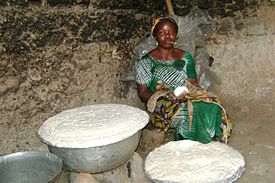- Kenkey
-
Kenkey or Dokonu or Komi is a staple dish similar to a sourdough dumpling from the Akan, Ga and Ewe inhabited regions of West Africa, usually served with a soup, stew, or sauce. Areas where Kenkey are eaten are southern Ghana, eastern Côte d'Ivoire, Togo, western Benin and Jamaica. It is usually made from ground corn (maize), like sadza and ugali. Unlike ugali, making kenkey involves letting the maize ferment before cooking. Therefore, preparation takes a few days in order to let the dough ferment. After fermentation, the kenkey is partially cooked, wrapped in banana leaves, corn husks, or foil, and steamed. There are several versions of Kenkey, such as Ga and Fanti kenkey.
Contents
Ingredients
- 6-8 cups of corn (maize) flour or cornmeal (ground corn or ground maize); (White cornmeal is preferred, it should be finely ground, like flour. Latin American style corn flour, as is used in tortillas, tamales, pupusas, etc. is the right kind)
- Banana leaves, or maize or corn husks, or aluminum foil to wrap dough in (the leaves or husks may be available at African, Asian, or Latino groceries)
Preparation
Fermented cornmeal dough
Traditional method
In a large container combine the corn flour (or corn flour and grated cassava) with just enough warm water to dampen all of it. Mix well. Cover the container with a clean cloth. Set it in a warm place, such as a warmed oven or on top of the refrigerator, for two to three days. Fermentation may take longer than two days, especially in cool climates. (Note: a warmed oven is an oven that has been heated for a few minutes then turned off. The flour should ferment, not cook.) When it is properly fermented, it should have a slightly sour, but not unpleasant, aroma,like rising bread dough. Overly fermented corn flour will not taste right.
Alternate method
Prepare the corn flour as described above, and let it ferment for about six hours. Then mix one tablespoon of vinegar into the wet corn flour.
Soak the dry corn in water. After three days drain and wash the corn in fresh water. Grind it and add some water to make it into a dough with a smooth surface. Keep it in a warm place to ferment for two to three days before using it to prepare the kenkey. Before using it for the preparation the mouldy surface on top should be removed and discarded.
Kenkey
- Knead the fermented dough with your hands until it is thoroughly mixed and slightly stiffened.
- In a large pot, bring one cup of water to a boil. Slowly add one part of the fermented dough. Cook for about ten minutes, stirring constantly and vigorously. Remove from heat. This half of the dough is called the "aflata".
- Combine the aflata with the remaining uncooked dough. Mix well. The proportion of raw dough to aflata determines the softness of the kenkey after cooking.
- Divide the aflata-dough mixture into serving-sized pieces. Wrap the pieces tightly in banana leaf, maize or corn husks, or foil. Banana leaves are more flexible if they have been briefly warmed in a hot oven or a pot of boiling water. The wrapped dough should look like burritos or tamales. Cooking string can be used to tie the wrapping closed.
- Place the wrapped dough packets on a wire rack above water in a large pot. Bring to a boil and steam for one to three hours, depending on their size and thickness. Serve room-temperature.
- Ga Kenkey is usually served hot with a red pepper sauce made of ground chili pepper, onions and tomatoes; and a black pepper sauce locally called shito.
- Fanti Kenkey is usually served warm with tomato gravy or palaver sauce. It may also go with any fish, poultry, or meat dish from Western Africa. In Ghana, guests are often served Fanti Kenkey with red pepper sauce and canned sardines or fried fish, especially if they have arrived unannounced or after the family's evening meals.
The water used in boiling the kenkey is used as a drink when a maize or corn husks is used as the wrapper for cooking the kenkey. This water is called otinshi nu.
Note: Ready-to-use fermented cornmeal dough made especially for banku and kenkey may be available at African grocery stores and should be prepared according to package instructions.
See also
References
External links
American cuisine Latin AmericaAsian cuisine East AsiaChinese: Baozi · Ci fan tuan · Dim sum · Fun guo · Har gow · Hujiao bing · Jau gok · Jiaozi · Lo mai gai · Shengjian mantou · Shumai · Siopao · Suanla chaoshou · Tang bao · Tangyan · Taro dumpling · Wonton · Xiaolongbao · Zhaliang · Zongzi · Other: Akashiyaki · Buuz · Dango · Khuushuur · Mandu · Mandugwa · Manduguk · Mitarashi dango · MomoSouth East AsiaVietnamese: Ba-wan · Bánh bao · Bánh chưng · Bánh lá · Bánh tẻ · Bánh tét · Other: Caozai Guo · Kueh tutu · Kuih kochi · NagasariWest AsiaNorth AsiaEuropean cuisine Bryndzové halušky · Halušky · Kalduny (Kundumy) · Kopytka · Pierogi · Scovardă · Shlishkes · Strapačky · Uszka · VarenykySouthern EuropeCentral EuropeCapuns · Kluski · Knedle · Knödel · Maultasche · Mohnnudel · Pickert · Schupfnudel · Silesian dumplingsWestern EuropeNorthern EuropeOther AustraliaKenkeyCategories:- Ghanaian cuisine
- African cuisine
- Dumplings
Wikimedia Foundation. 2010.

